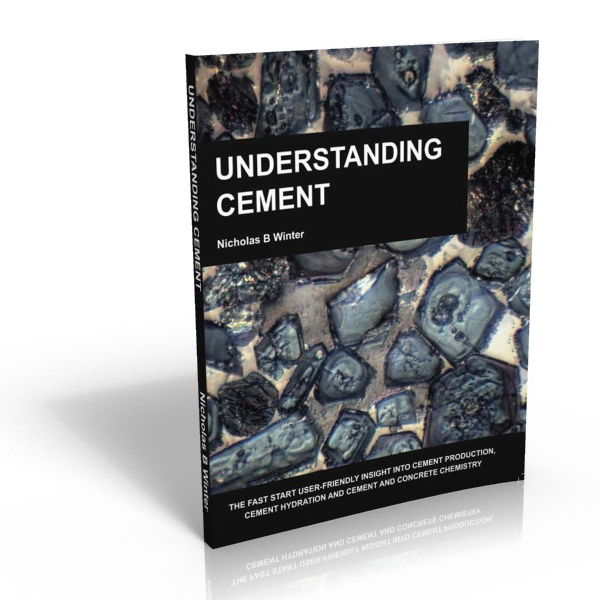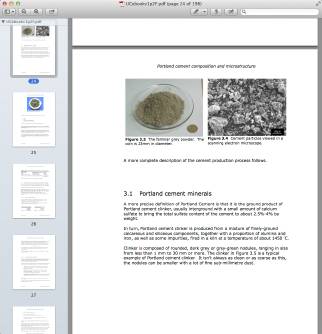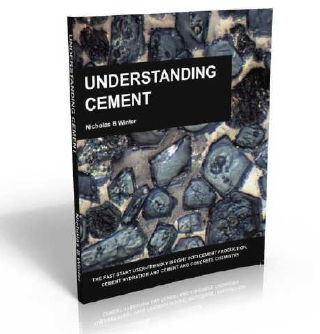Seven Reasons Why The "Understanding Cement" Book
Gives You the Fastest Route to Understanding
How Cement Really Works

THE UNDERSTANDING CEMENT BOOK: The Fast Start User-Friendly Insight Into Cement Production, Cement Hydration and Cement and Concrete Chemistry
- Gives the essentials of how cement is made and what happens when you use it in concrete or mortar.
- Shows you how to look at cementitious systems and understand how they work, eg: why adding slag to a mix may be beneficial, or what happens when you change the water-cement ratio.
- Provides a structured system - a "mental map" if you like - into which you can "plug" all your cement knowledge, including what you know already, what you learn from this book and what you learn in the future.
- Once you really "get" this structured system, you can predict how vital factors such as strength or resistance to deleterious processes are likely to alter with changes to the mix.
- Unlike a normal textbook that just throws a lot of facts at you that you then have to remember, the structured system that this book encourages you to develop helps you retain your knowledge, because it all fits together.
- Based on my 26 years' experience of providing cement-related consulting to clients in the various parts of the construction industry, this book contains what almost all of them need to know (and most of them do - now!). No fluff, no academic irrelevancies, just the facts.
- Written in an informal style that is easy to read. This is really important if normal "heavy duty" textbooks just send you to sleep, or (as is the case for perhaps a third of those who have already purchased it) if English is not your first language.
"Great book, I had a copy but lent it and never got it back. A good indication of its usefulness. I lend this book to my new chemists and engineers to read, as a very concise and easy to follow text. They always ask if they can read-up on cement manufacture and a copy of Lea, Taylor or Locher just scares them off the subject. However your text has just the right level of detail and coverage.
I've been in the industry for almost 30 years and this is the only book available which is at a suitable level for new graduates coming into the industry to get a good understanding of cement."
Bret Barnett, Technical Manager, BGC Cement, Western Australia
"An excellent book - should be a standard (if not THE standard) for all concrete/cement technicians and technologists."
- Mike Burton, Kirton Concrete Services, UK.
"If only you had written this book when I was still working!! It really does explain cement and of course is up-to-date with composite cements and with 'making cement greener'"
-Geoff Bowler, Technical and Environmental Research Manager (retired), Bude, UK.
When I started working for a cement manufacturer many years ago, I knew nothing about cement at all and the learning curve was very steep. Without this book, or anything like it, it took me some years before I felt I had anything like a good working knowledge of cement.
In this book, I've aimed to give anyone wanting to know more about cement today with a rocket-assisted start.
It has an informal writing style (this is no stuffy old textbook!) with the aim of giving the simplest and clearest possible introduction to cement science.
You may be interested in cement for all sorts of reasons; for example, maybe you are:
- a technical manager or other "seasoned professional" who wants a convenient reference book, or to to brush up on some cement science
- starting out in a career in cement or concrete or masonry
- an engineering or chemistry student
- responsible for teaching/training
If you want to know more about cement, or are working with people who do, this book is written for you - and for them.
It contains everything I think you need to know as a student of cement, and it contains very little that you probably don't need to know or that you won't find useful sometime. If you want to know more, there are references to other books to guide you in the 'further reading' section.
At first sight, cement can seem confusing...
When you first look at what is actually in cement, you quickly find that it is a lot more complicated than you probably first thought. It contains a range of complex minerals, and a whole different set of even more complex minerals when it hydrates. To the beginner, it can be very confusing.
Even worse is the arcane system of chemical notation that cement science uses. When I was first introduced to it, I was convinced that cement science was quite mad and that I would never understand it.
As time passed though, things became clearer. I was helped a lot by some very knowledgeable people at the cement company research division where I worked, and I also read books.
The trouble with books on cement then, was that while the content was excellent, they were often too difficult for beginners and written in a dry, formal, style that didn't help me to learn. I'm not sure that things have changed a lot.
Until now.
So what's this book all about?
The main subjects covered are:
- cement production - how Portland cement is made
- cement hydration - what happens when you mix cement with water
- deleterious processes in cement - alkali-silica reaction, sulfate attack etc.
I set up the Understanding Cement web site in 2005 as a basic introduction to cement science and it has proved very popular. The Understanding Cement book covers some of the same material but the subject range is wider and more detailed.
If you find the Understanding Cement web site useful, you will find the book even better. It is an integrated book rather than a series of articles and it goes into more detail of many aspects of cement compared with the web site.
There are twelve chapters - here is the contents page from the printed version (the e-book version is similar):
|
|||||||||||||||||||||||||||||||||||||||||||||
For the last 28 years, I have worked as an independent consultant offering microscopy and cement chemistry services to the cement and construction industries. Microscopy is all about interpreting images, so I've developed a very 'visual' approach to cement.
They say that a picture is worth a thousand words. The Understanding Cement book has over seventy images and diagrams, so that should save a lot of reading. Many of the images are microscope images from optical and scanning electron microscopes and these really help to understand what cement is all about.
If you read two chapters a day and really think about and absorb the content, within a week you should have a good understanding of the basics of cement science. The first chapter, on cement history, is short and really easy, so that won't take long!
(Even at a more leisurely pace of just one chapter a day, it would still take you less than two weeks...)
Some chapters contain sections you may have to think about carefully. Cement is, in parts, a complex subject and I do not pretend it will all be easy. Stick with it, though, and you will be fine.
Cement concepts
The innovative chapter on 'Cement Concepts' is an invitation to share some thought experiments. This gives you the "structured framework" - the mental map that is so important.
These thought experiments are great - they are much quicker and less messy than real experiments and the insights gained will be useful for years. Some of these thought experiments are easy, while others are more challenging.
Extensively tested
I wanted to be as sure as possible that it was as accurate and as easy to read as I could make it, so I sent the manuscript of the original e-book to two different groups of people to review.
The first group was the 'expert group' - these were people who had spent their lives working with cement, in careers that included cement manufacturing, concrete, mortar, testing, civil engineering and education. Some are still working and some are retired, having amassed a lifetime's experience. The main purpose of this group was to check the technical content.
The second group was made up of people with a technical background, but who had no specialised cement knowledge. This group's job was to tell me which parts were easy to understand and which parts were more difficult, where I had not explained things clearly enough.
I didn't want useless platitudes from these two groups, I wanted these people to tear the e-book apart and tell me what was wrong. And they did, bless them! Their feedback helped me to improve greatly both the content and readability.
I have known many of the reviewers for a long time - most are clients, colleagues or friends and indeed a couple are family members. I enlisted the help of each of them because of their skills and knowledge, and their gift of plain-speaking. I am very grateful to all of them for giving their time and skills, for which they received no payment.
Feedback from reviewers
Although I wasn't seeking compliments from the reviewers (quite the opposite, I wanted criticisms) I had so many positive comments that it would be churlish of me not to share a few more of them!
"An invaluable insight into cement chemistry, production and behaviour, delivered in an unambiguous fashion that is easy on the eye of the reader; a complex subject made easy, so much so that one wonders why this particular subject is often so difficult in its understanding to the user - certainly a tribute to the author's enthusiasm for the subject and ambition to open up such knowledge to a wider audience in an interesting yet informative style."
- Ian Ferguson, Group Concrete Technologist, Marshalls PLC, UK
"It should certainly be on the reading list for all budding civil engineers."
- Robert Matthews, Civil Engineer (retired), Oxford UK.
Understanding Cement summary
"Understanding Cement" contains a wealth of information on cement that may well be pretty much all you need. If you do want to take your studies of cement further, it contains numerous suggestions for further reading; having read Understanding Cement, you will be able to tackle the more formal textbooks with enthusiasm and confidence.
- How Portland cement is made
- What happens when you mix cement and water
- Why you might consider using slag, fly ash or other mineral additions in concrete
- 'Cement Concepts' - helps you visualise what happens in the cement kiln and in different concrete mixes
- Deleterious processes: ASR, sulfate attack, DEF, steel corrosion, carbonation
- 206 pages, 70+ images
Which version should I get and what do they cost?
There are TWO VERSIONS of the Understanding Cement book. Choose the version that is right for you.
The PRINTED VERSION will be shipped to you, having been produced using "print on demand" technology. It costs $65.00 US plus $12.00 US shipping by the US Postal Service.
We can ship books using the US Postal Service to: USA; Canada;
United Kingdom; Australia; New Zealand; all EU countries; Iceland;
Norway and Switzerland. For other countries, it may be better to use a courier service such as DHL, so please contact us for a quotation before ordering. Or, you may wish to consider the e-book version.
How quickly the book reaches you will depend where you are. The book is
printed and posted in the USA and postal destinations within the USA should
receive it within a few days of shipping. International shipping is by
first class airmail; time taken will depend on destination and any
delays due to customs. As an example, a book sent to the United Kingdom
typically arrives 1-2 weeks after ordering. Books shipped by courier usually arrive a little more quickly, but the cost is higher.
The E-BOOK VERSION is a downloaded pdf file (file size about 7 MB) that you can download now and read on any computer using Acrobat Reader. You can either read it straight from your computer screen, or you may prefer to print it out and bind it with a comb or wire binder - do whatever you are most comfortable with! It costs $47.00 US.
If you are happy to read a book from your computer screen, then get the e-book version. If (like me) you prefer to read a real book then get the printed version.
DIFFERENCES BETWEEN THE TWO VERSIONS
The two versions are similar, but there are minor differences:
- The illustrations in the printed version are black-and-white, while some images in the e-book version are in color.
- The printed version has an index. To find subjects with the e-book version you can use the "Find" function in Acrobat Reader.
- The text of the printed version is similar to the text of the original e-book version written in 2009, but with minor amendments to improve clarity and to update the "recommended reading" section.
Book details (printed version)
Price: $65.00 US (+$12.00 shipping)
Paperback: 206 pages
Publisher: WHD Microanalysis Consultants Ltd., December 2012, (based on the 2009 e-book text, with amendments)
Language: English
ISBN-13: 978-0-9571045-2-5
Book dimensions: 8 x 10.5 inches; 203 x 267 mm

100%
RISK-FREE
60-DAY MONEY BACK GUARANTEE
In a bookstore, you can look through a book before you buy. You can't do that here, so we offer a 60-day money back guarantee.
Try "Understanding Cement" now, risk-free. If you decide it isn't for you for any reason, just return the book to us in good condition within 60 days and we'll refund what you paid for the book (less shipping),
no questions asked. (For the e-book version there's nothing to return, so just tell us within 60 days that it isn't for you and we'll refund your payment.
How to to get your copy now
The "Understanding Cement" book and e-book are available ONLY direct from the publisher via this website. You won't find them in bookshops or on Amazon.
They can be obtained through the links below. Just choose whether you want the book or e-book, and click the appropriate "Add to Cart" button and this will take you to the shopping cart where you can review your purchase. Please make sure you have the right version of the book in your shopping cart!
If you purchase the printed book, it will be printed and sent to you as soon as possible. If you purchase the e-book, after the transaction you will be sent an email with a link where you can download your Understanding Cement e-book.
Get "Understanding Cement" now, risk-free, and start to see cement in a new light!

PRINTED BOOK AND E-BOOK BUNDLE AT NO EXTRA COST!
Some people have said they would find it useful to have BOTH the printed book AND the e-book so they can have the printed copy and also the e-book on their laptop.
So, as an experiment to find out how many people really would like both versions, for a limited time we have a special offer:
***THE PRINTED BOOK PLUS A FREE COPY OF THE ORIGINAL E-BOOK***
(NOTE: Offer applies only to individual purchasers, ie: you are buying it for your own personal use: not applicable to purchases by eg: libraries or book distributors.)
Just order the printed version below and we'll tell you by e-mail how you can request your bonus personal Understanding Cement e-book.
CUSTOMERS IN THE EUROPEAN UNION (EU): as a temporary measure, we very much regret that we cannot supply the printed book to countries within the European Union; this is due to the change in EU VAT rules for physical goods. We hope to resolve this issue soon. This only applies to the printed version of the book. Purchase of the e-book version is unaffected and is fully compliant with EU rules. (If you do order the printed book to be delivered to a country within the EU, it is at your own risk! The book will be sent to you but it may be delayed in customs in your country and you may be asked for an additional payment for tax/import duty before the book is delivered to you, or your customs may simply return the book to us undelivered.)
Choose your version of "Understanding Cement"!
"Understanding Cement"
***E-BOOK VERSION***
PDF Download (7MB)
$47.00 (US)
(Note: depending on your location, country or state sales taxes may apply. The shopping cart will show the net amount, tax and total.)
Example page from e-book shown
"Understanding Cement"
***PRINTED VERSION***
$65.00 (US)
(+$12.00 shipping)
SPECIAL NOTE: at present, we cannot supply the printed book to countries within the European Union, so for now please do not choose this option if you are in the EU. You may wish to consider the e-book version instead.
PLUS:
Bonus e-book version at no additional cost*
(*individual purchasers only)
Wishing you great success in your studies of cement!
Warmly,

Nicholas Winter
PS: Don't forget - the Understanding Cement printed book is just $65.00 US (+$12.00 shipping), including, for an experimental period only, the bonus e-book version at no extra cost. Or, the e-book version is just $47.00 US. Either way, you have a 60-day money-back guarantee. Just click on one of the links above.


